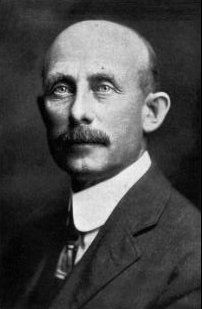George Stewart Henry
George Stewart Henry (born July 16, 1871 in Township of King , York County , Ontario ; † September 2, 1958 in Toronto , Ontario) was a Canadian politician who chaired the Conservative Party of Ontario between 1930 and 1936 and at the same time from 1930 to 1934 was Prime Minister of Ontario . Henry served on the Ontario Legislative Assembly for nearly 30 years from 1913 to 1943 .
Life
Degree and local politician
After attending Upper Canada College (UCC), Henry first completed an undergraduate degree at the University of Toronto , which he completed with a Bachelor of Arts (BA). A thereat postgraduate studies of law he finished with a Bachelor of Laws (LL.B.) and studied one year at the Ontario Agricultural College , the Agricultural Science Faculty of the University of Toronto. He then settled in East York as a farmer and entrepreneur .
Henry began his political career in local politics and was a member of King Parish between 1903 and 1910 and Reeve there between 1906 and 1910 . At the same time in 1909 he served as Warden of York County for some time .
On September 8, 1913, Henry was elected as a candidate for the Conservative Party of Ontario in a by-election in the constituency of York East for the first time as a member of the Legislative Assembly of Ontario and was this until June 30, 1943 for almost 30 years.
Member of the House of Commons and Minister of the Provincial Government
Prime Minister William Howard Hearst appointed him on May 23, 1918 for the first time in the government of the province of Ontario, where he was Minister of Agriculture until the end of Hearst's tenure on November 14, 1919.
After the Conservative Party's victory in the June 25, 1923 elections, Henry was appointed Minister of Public Works and Highways by Prime Minister Howard Ferguson and held that ministerial office until December 15, 1930.
Prime Minister of Ontario from 1930 to 1934 and defeated in 1934
After the resignation of Prime Minister Ferguson, Henry became his successor on December 15, 1930 and thus 10th Prime Minister of Ontario. At the same time he followed Ferguson as chairman of the Conservative Party of Ontario. In his government he served between December 15, 1930 and July 10, 1934 as Minister of Education and was also Minister of Highways from December 15, 1930 to July 31, 1931, and most recently between January 12 and July 10 1934 also treasurer (finance minister) of the provincial government. The most important members of the provincial government also included Agriculture Minister Thomas Laird Kennedy , who himself was Ontario's Prime Minister between 1948 and 1949.
As prime minister, he continued in particular the economic policy of his predecessor, albeit under the influence of the global economic crisis . For example, the sale of high-proof alcoholic beverages, which was only allowed by the Liquor Control Board of Ontario , brought considerable additional income, as did the state electricity production. A large part of this flowed into the road expansion.
After eleven years of reign under Ferguson and him as Prime Minister, the Conservative Party suffered a dramatic defeat in the elections to the legislative assembly on June 19, 1934. Compared to the previous elections on October 30, 1929, it lost 75 of its 92 seats and had only 17 seats in the legislative assembly, which had been reduced from 112 to 90 seats. The election winner was the Ontario Liberal Party , which was able to improve its result by 55 seats and now had 69 instead of 14 members. One mandate each went to the Co-operative Commonwealth Federation (CCF), Labor Party, United Farmers of Ontario (UFO) and one non-party .
Mitchell Hepburn then succeeded Henry as Prime Minister on July 10, 1934, of the Liberal Party.
Henry then became the leader of the opposition in the Legislative Assembly as chairman of the largest opposition faction . In 1938 he passed this position on to George A. Drew , who also succeeded him as chairman of the Conservative Party of Ontario. On June 30, 1943, after almost 30 years in parliament, he resigned his mandate in the legislative assembly and withdrew from political life.
Web links
- Entry on the Ontario Legislative Assembly homepage
Individual evidence
- ↑ Canadian Provinces (rulers.org)
| personal data | |
|---|---|
| SURNAME | Henry, George Stewart |
| BRIEF DESCRIPTION | Canadian politician and 10th Prime Minister of Ontario |
| DATE OF BIRTH | July 16, 1871 |
| PLACE OF BIRTH | Township of King , York County , Ontario |
| DATE OF DEATH | 2nd September 1958 |
| Place of death | Toronto , Ontario |
